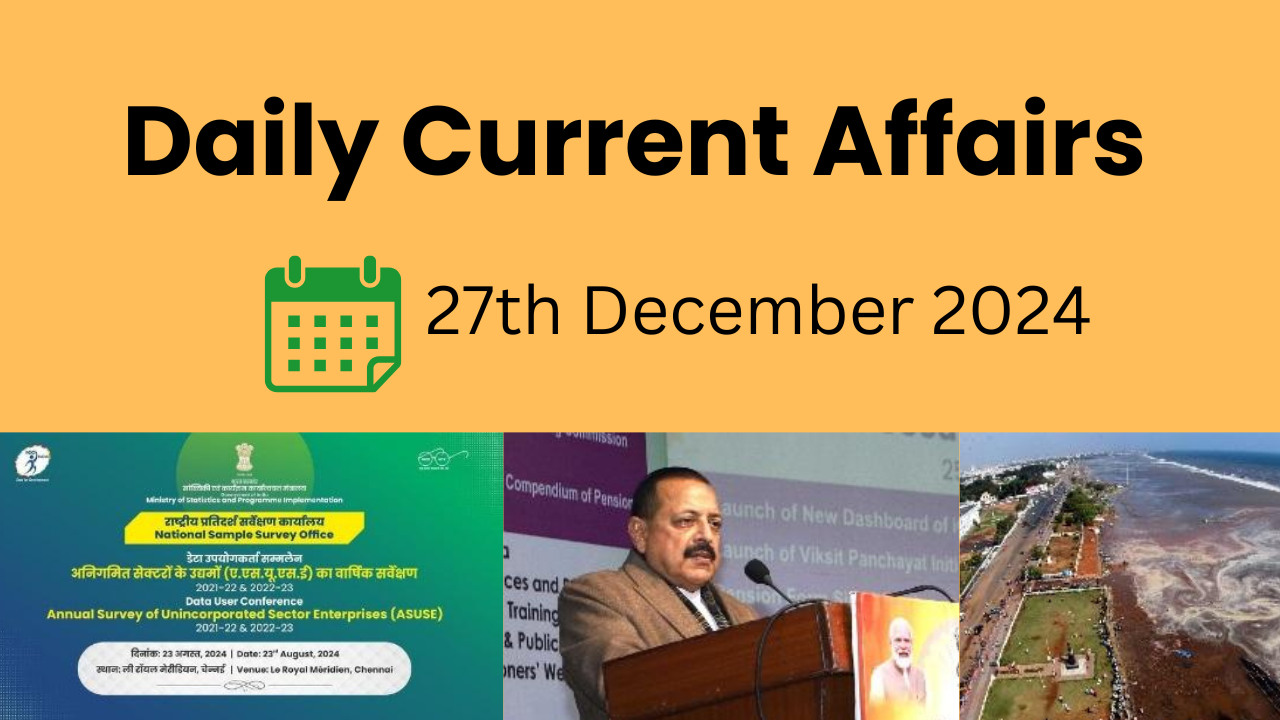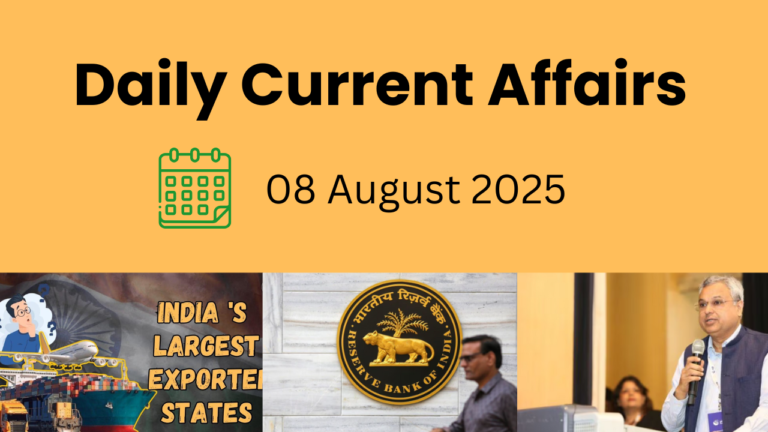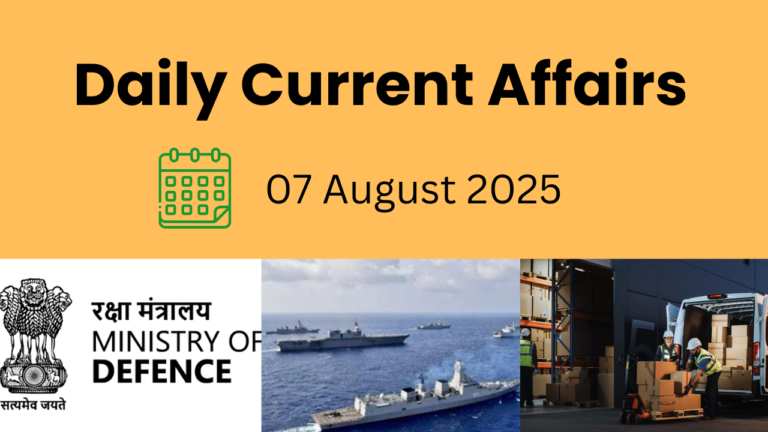1. Ken-Betwa River Linking Project: A Step Towards Water Sustainability
Context: Prime Minister Narendra Modi recently laid the foundation stone for the Ken-Betwa River Linking Project, a significant initiative aimed at addressing water scarcity in India’s Bundelkhand region.
Ken-Betwa River Linking Project Overview:
Project Details:
- This project will transfer water from the Ken River to the Betwa River, both tributaries of the Yamuna.
- It includes the construction of the 221 km-long Ken-Betwa Link Canal, which features a 2 km tunnel.
- The project is divided into two phases:
- Phase I: Construction of the Daudhan Dam Complex and subsidiary units.
- Phase II: Development of the Lower Orr Dam, Bina Complex Project, and Kotha Barrage.
Region Benefited:
- The project will primarily benefit the Bundelkhand region, which spans 13 districts across Madhya Pradesh and Uttar Pradesh, alleviating its water scarcity problems.
Timeline:
- The project is expected to be completed in eight years.
National Perspective Plan for Interlinking Rivers (ILR)
The project is a part of the National Perspective Plan (NPP), introduced in 1980 by the Ministry of Water Resources and the Central Water Commission. The National Water Development Agency (NWDA) oversees this program.
Key Components of the NPP:
- Himalayan Rivers Development:
- Construction of storage reservoirs on the Ganga and Brahmaputra tributaries in India, Nepal, and Bhutan.
- Linking canals to transfer surplus water from the eastern Ganga tributaries to the western regions.
- Peninsular Rivers Development:
- Interlinking rivers like the Mahanadi, Godavari, Krishna, and Cauvery.
- Developing west-flowing rivers near Mumbai and south of Tapi.
- Linking rivers such as Ken and Chambal.
Significance of River Linking Projects:
- Tackling Water Scarcity: Transfers surplus water from water-rich areas to water-deficient regions.
- Agricultural Boost: Increases water availability for irrigation, improving agricultural productivity.
- Flood Mitigation: Helps in distributing excess water during heavy rains, reducing flood risks.
- Hydropower Generation: Reservoirs and canals create opportunities for renewable energy.
- Employment Opportunities: Construction and maintenance generate jobs, boosting local economies.
- Dispute Resolution: Equitable distribution of water reduces inter-state conflicts over resources.
Challenges of River Linking Projects:
- Environmental Impact: Altering river courses disrupts ecosystems, leading to biodiversity loss and habitat destruction.
- Community Displacement: Dams and reservoirs displace populations, causing social and economic hardships.
- Inter-State Conflicts: Disagreements over water sharing can lead to prolonged legal disputes.
- Financial Constraints: High costs of construction and operation often exceed initial estimates, raising concerns about economic viability.
- Seismic Risks: Large dams in earthquake-prone areas increase the risk of catastrophic failures.
- Maintenance Challenges: Poor upkeep can result in system breakdowns and inefficiencies.
- Resistance from Communities: Opposition from locals and environmentalists due to potential livelihood and cultural losses.
Conclusion:
The Ken-Betwa River Linking Project is a bold step toward addressing water scarcity and fostering development in underprivileged regions. However, to ensure long-term success, the government must address environmental, social, and financial concerns through:
- Comprehensive planning and impact assessments.
- Engaging local communities in decision-making.
- Adopting sustainable practices and modern technologies.
Striking a balance between development and sustainability is essential for the success of such projects, ensuring both human and ecological well-being.
2. Annual Survey of Unincorporated Sector Enterprises (ASUSE) 2023-24
Context: The Ministry of Statistics and Programme Implementation (MoSPI) has released the Annual Survey of Unincorporated Sector Enterprises (ASUSE) for the year 2023-24, covering the period from October 2023 to September 2024. This survey provides vital insights into the performance of the unincorporated non-agricultural sector in India.
Scope of ASUSE:
- Geographical Coverage: The survey encompasses both rural and urban areas across India, excluding villages in the Andaman and Nicobar Islands.
- Sectoral Coverage: It focuses on unincorporated non-agricultural establishments in three key sectors:
- Manufacturing
- Trade
- Other Services (excluding construction).
- Economic Characteristics Analyzed: Metrics such as number of workers, Gross Value Added (GVA), emoluments paid, fixed assets owned, and outstanding loans.
Key Findings from ASUSE 2023-24:
- Growth in Establishments: The number of establishments rose significantly from 6.50 crore in 2022-23 to 7.34 crore in 2023-24, reflecting a robust 12.84% growth.
- Enhanced Economic Contribution:
- Gross Value Added (GVA): GVA increased by 16.52%, driven by a 26.17% rise in the other services sector.
- Labour Productivity: GVA per worker grew by 5.62%, reaching ₹1,49,742 in 2023-24, compared to ₹1,41,769 in 2022-23.
- Gross Value of Output (GVO): GVO per establishment rose from ₹4,63,389 to ₹4,91,862, highlighting improved enterprise efficiency.
- Strong Labour Market Performance:
- Female Entrepreneurship: The share of female-owned proprietary establishments increased from 22.9% in 2022-23 to 26.2% in 2023-24.
- Wage Growth: Average emoluments per hired worker grew by 13%, indicating better wage levels.
- Improved Digital Adoption: The percentage of establishments using the internet surged from 21.1% in 2022-23 to 26.7% in 2023-24, reflecting enhanced digital penetration.
Conclusion: The ASUSE 2023-24 highlights the dynamic growth and productivity of India’s unincorporated sector. With a surge in establishments, increased female entrepreneurship, higher wages, and improved digital adoption, the data provides valuable insights for:
- Policymaking
- National Accounts Statistics
- Supporting key ministries such as MSME, Textiles, and Labour & Employment.
These findings empower stakeholders to make informed, data-driven decisions, ensuring the continued growth and resilience of the unincorporated sector.
3. Celebrating 100 Years of the Belagavi Session of the Indian National Congress
Context: The Indian National Congress (INC) is commemorating the 100th anniversary of its historic Belagavi Session with a series of events, including a two-day extended Congress Working Committee (CWC) session and a public rally themed ‘Jai Bapu, Jai Bhim, Jai Samvidhan.’
The Belagavi Session of 1924: A Turning Point in History:
When and Where:
- The 39th session of the INC was held in Belagavi (then Belgaum), Karnataka, on December 26-27, 1924.
- This period marked significant political activity and growing momentum in India’s struggle for independence.
Mahatma Gandhi’s Leadership:
- It was the only time Mahatma Gandhi presided as the Congress president.
- His leadership emphasized unity, non-violence, and collective action, which became the bedrock of India’s freedom movement.
Participants:
- The session was attended by eminent leaders such as Jawaharlal Nehru, Sardar Vallabhbhai Patel, Sarojini Naidu, and Khilafat leaders Muhammad Ali Jauhar and Shaukat Ali.
Key Decisions and Highlights:
1. Non-Cooperation and Civil Disobedience:
- Gandhi reaffirmed his dedication to non-cooperation and civil disobedience as effective strategies against British oppression.
- These principles inspired major movements like the Salt March and the Quit India Movement.
2. Promotion of Khadi:
- The session emphasized Khadi as a symbol of self-reliance and resistance to British economic exploitation.
- This initiative aimed to rejuvenate indigenous industries and reduce dependency on British goods.
3. Communal Harmony:
- Gandhi advocated for communal unity, stressing the importance of harmony among India’s diverse religious and ethnic communities.
- This was crucial in countering the divisive policies of the colonial regime.
Significance of the Belagavi Session:
1. Gandhi’s Leadership Legacy:
- The session showcased Gandhi’s unwavering commitment to non-violence, communal harmony, and Swaraj (self-rule).
- His strategies laid the foundation for future anti-colonial movements.
2. Strengthened Freedom Movement:
- The session fostered peasant awareness, promoted Khadi, and encouraged village industries, particularly in Karnataka.
- It mobilized greater participation from peasants in Congress-led initiatives.
3. Unity in Diversity:
- Prominent leaders like Lala Lajpat Rai, C. Rajagopalachari, Maulana Abul Kalam Azad, and Sarojini Naidu participated, symbolizing the collective resolve to achieve independence.
4. Cultural Resonance;
- The event featured cultural highlights like the song ‘Udayavagali Namma Chaluva Kannada Nadu,’ performed by noted vocalist Veene Seshanna, which became an anthem for Karnataka’s unification.
Conclusion:
The Belagavi Session of 1924 was a defining moment in India’s freedom struggle. It reflected Gandhi’s visionary leadership, unity among leaders, and the integration of cultural expressions in the fight against colonialism. This centenary celebration honors the indomitable spirit and resolve that brought India closer to independence.
4. India and Saudi Arabia: Advancing Defence Cooperation Through Joint Ventures
Context: India and Saudi Arabia are strengthening their defence collaboration by exploring joint ventures and industrial partnerships aimed at localizing defence production and achieving mutual growth in the sector.
India-Saudi Arabia Defence Collaboration:
A Shared Vision for Self-Reliance:
- Both nations are committed to enhancing defence manufacturing under Vision 2030 (Saudi Arabia) and Make in India (India).
- Saudi Arabia aims to localize 50% of its defence spending, aligning with India’s goal of boosting indigenous defence production.
Key Initiatives and Contracts:
- Saudi Arabia signed a $250 million deal for ammunition with Munitions India Limited, a Defence PSU.
- The kingdom also procured the 155mm Advanced Towed Artillery Gun System (ATAGS) from Bharat Forge.
Joint Military Exercises:
- Al Mohed Al Hindi: A bilateral naval exercise launched in 2022.
- Sada Tanseeq: The inaugural Army exercise held in Rajasthan in January 2024.
- Tarang Shakti: Saudi Arabia participated as an observer in India’s largest air exercise.
India-Saudi Arabia Relations: A Broader Perspective:
1. Political Relations:
- Diplomatic ties were established in 1947.
- The Delhi Declaration (2006) and Riyadh Declaration (2010) elevated bilateral relations to a strategic partnership.
- In 2019, the Strategic Partnership Council (SPC) Agreement created a high-level mechanism to deepen ties.
2. Economic Relations:
- India is Saudi Arabia’s second-largest trade partner, while Saudi Arabia ranks as India’s fourth-largest trade partner.
- Bilateral trade reached $43.3 billion in 2023-24.
- Saudi investments in India totalled $3.15 billion, with 2,783 Indian companies operating in Saudi Arabia as of 2022.
3. Energy Cooperation:
- Saudi Arabia was India’s third-largest source of crude oil in FY23, supplying 39.5 MMT, which accounted for 16.7% of India’s total crude imports.
- India’s LPG imports from Saudi Arabia stood at 7.85 MMT in FY23.
4. Indian Diaspora:
- As of 2023, 2.6 million Indians live in Saudi Arabia, forming the second-largest foreign workforce in the kingdom after Bangladesh.
Future Outlook: A Partnership for Growth:
- The shared goal of reducing reliance on defence imports and boosting domestic production offers immense opportunities for both nations.
- Collaboration in advanced technologies such as AI and cybersecurity can further bolster their strategic autonomy.
- Aligning objectives under Vision 2030 and Make in India, India and Saudi Arabia are well-positioned to emerge as global leaders in defence innovation.
- Continued cooperation will ensure the success of Indian workers in Saudi Arabia, fostering greater economic stability and development for both countries.
Conclusion:
The evolving defence partnership between India and Saudi Arabia is a testament to their shared vision of self-reliance, innovation, and economic growth. By working together on defence localization and technological advancements, both nations can significantly impact the global defence landscape while deepening their bilateral ties.
5. Viksit Panchayat Karmayogi Initiative: Strengthening Grassroots Governance
Context: On Good Governance Day, the Union Minister of Personnel, Public Grievances, and Pensions launched the Viksit Panchayat Karmayogi Initiative, marking a significant step toward empowering Panchayati Raj Institutions (PRIs) and fostering participatory governance at the grassroots level.
About the Initiative:
Empowering Panchayati Raj Institutions:
- Focused on enhancing the effectiveness of PRIs through innovative tools and capacity-building frameworks.
- Piloted in Odisha, Assam, Gujarat, and Andhra Pradesh.
- Utilizes e-learning platforms, AI-powered chatbots, and mobile applications to bridge knowledge gaps and improve service delivery.
Aligned with Decentralized Governance Goals:
- Part of the broader ‘Prashasan Gaon Ki Aur’ campaign, aimed at decentralizing governance and promoting citizen participation in decision-making.
- Seeks to equip elected representatives and officials with the knowledge and tools needed for effective governance and inclusive planning.
Driving Sustainable Development:
- Aims to create scalable models of citizen-centric governance, enabling PRIs to lead equitable and sustainable development across rural India.
Other Key Initiatives Launched:
1. iGOT Karmayogi Platform Dashboard:
- Designed to empower ministries, departments, and state administrators with advanced tools for monitoring progress in capacity building.
- Features include:
- Tracking user registrations and course completions.
- Providing customizable views and robust data filtration for better insights.
- Enhances decision-making and optimizes training initiatives through detailed progress analysis.
2. CPGRAMS Annual Report 2024:
- Offers a comprehensive review of the Centralized Public Grievance Redress and Monitoring System (CPGRAMS).
- Highlights achievements such as:
- Resolution of over 25 lakh grievances annually.
- Implementation of the Grievance Redressal Assessment and Index (GRAI) for improved grievance handling.
Significance:
- The Viksit Panchayat Karmayogi Initiative reflects the government’s commitment to enhancing grassroots governance.
- By leveraging technology and capacity-building programs, it aims to create a robust system for participatory decision-making, ensuring sustainable growth and development in rural areas.
Conclusion:
The initiative, along with complementary programs like the iGOT Karmayogi dashboard and CPGRAMS enhancements, underscores the government’s vision of empowering institutions and fostering good governance. These efforts collectively pave the way for a more responsive, inclusive, and efficient governance framework at all levels.
6. Transforming Tsunami Science: Key Lessons from the 2004 Indian Ocean Earthquake
Context: The year 2024 marks the 20th anniversary of the devastating 2004 Indian Ocean earthquake and tsunami, one of the deadliest natural disasters in recorded history. This anniversary serves as a crucial moment to reflect on the remarkable progress made in tsunami science, disaster preparedness, and mitigation strategies that have been inspired by the events of that tragic day.
The 2004 Indian Ocean Earthquake: A Catastrophic Event:
The Earthquake’s Origins:
- The earthquake struck 30 km beneath the ocean floor in the Sunda Trench, where the Indo-Australian plate subducts beneath the Burma microplate.
- It spanned a staggering 1,300 km from Sumatra to the Coco Islands, and was the third-largest earthquake globally since 1900.
Devastating Impact:
- The tsunami affected multiple countries, including Indonesia, India, Sri Lanka, and Thailand, causing immense damage.
- Approximately 227,000 people lost their lives, with 1.7 million displaced.
- Although tsunamis had struck the region in the past, none had been as catastrophic as the 2004 disaster.
Understanding Tsunamis:
What is a Tsunami?
- The term tsunami (Japanese for “harbour wave”) refers to a series of giant ocean waves triggered by sudden movements beneath the ocean, such as earthquakes, volcanic eruptions, or even meteorite impacts.
- Earthquakes cause large portions of the ocean floor to move, displacing vast volumes of water and creating waves that travel across the ocean at speeds akin to jet planes. These waves are not immediately dangerous in deep water, but become extremely destructive when they approach coastal areas.
Tsunami Wave Characteristics:
- Wave height increases as the wave enters shallow coastal waters, a phenomenon known as shoaling. This results in a dangerous increase in the tsunami’s force.
- The shape of the ocean floor and the distance of the earthquake’s epicenter determine the severity and characteristics of the tsunami.
Tsunami Warning Systems: A Lifesaving Advancement:
India’s Tsunami Warning Efforts:
- The Indian Tsunami Early Warning Centre (ITEWC) was established in 2007 under the Ministry of Earth Sciences at INCOIS, Hyderabad.
- It uses seismological stations, bottom pressure recorders, and tidal stations to monitor and issue tsunami alerts within 10 minutes of detecting a potential earthquake.
- India has become the fifth country globally to develop advanced tsunami warning systems, joining Japan, the U.S., Chile, and Australia.
Global Vulnerabilities and Case Studies:
At-Risk Regions:
- Makran Coast: A potential threat to India’s west coast, including cities like Mumbai.
- Myanmar Coast: A significant risk for the Northern Indian Ocean regions.
The Kalpakkam Nuclear Plant Case Study:
- The 2004 tsunami caused a shutdown at the Kalpakkam nuclear plant, though it resumed operations without any radioactive leaks.
- Lessons from Fukushima (2011) emphasized the need for robust safety protocols, as radiation leaks can have long-lasting and widespread consequences.
Key Lessons and Future Directions:
- The 2004 Indian Ocean tsunami was a wake-up call that highlighted gaps in disaster preparedness and tsunami science.
- Over the past two decades, countries have significantly improved their tsunami warning systems, allowing for faster response times and saving countless lives.
- Global cooperation, technology, and scientific advancements have made it possible to mitigate the risks posed by these devastating natural events.
By continually evolving and strengthening these systems, we can better prepare for future tsunamis, minimizing the impact on human lives and infrastructure.




